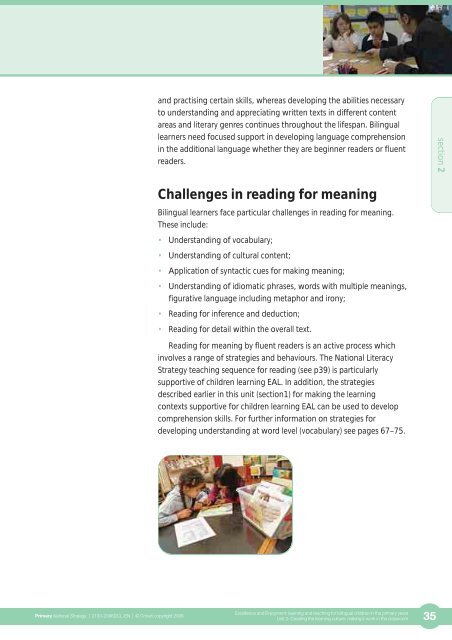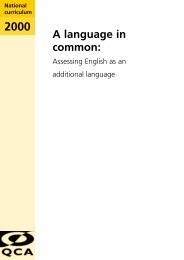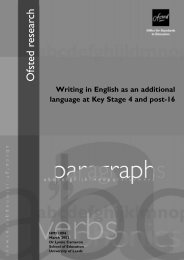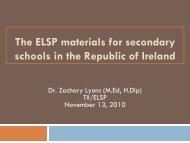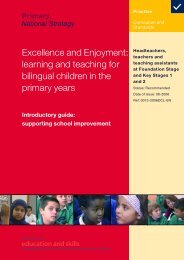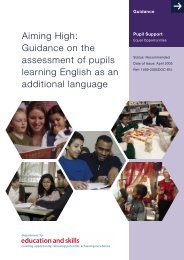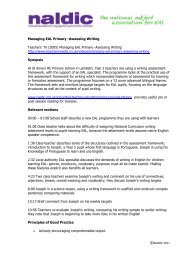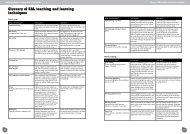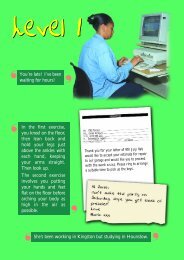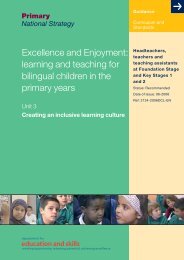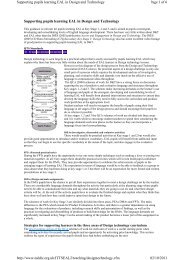Creating a learning culture: Making it work in the classroom - NALDIC
Creating a learning culture: Making it work in the classroom - NALDIC
Creating a learning culture: Making it work in the classroom - NALDIC
Create successful ePaper yourself
Turn your PDF publications into a flip-book with our unique Google optimized e-Paper software.
and practis<strong>in</strong>g certa<strong>in</strong> skills, whereas develop<strong>in</strong>g <strong>the</strong> abil<strong>it</strong>ies necessaryto understand<strong>in</strong>g and appreciat<strong>in</strong>g wr<strong>it</strong>ten texts <strong>in</strong> different contentareas and l<strong>it</strong>erary genres cont<strong>in</strong>ues throughout <strong>the</strong> lifespan. Bil<strong>in</strong>guallearners need focused support <strong>in</strong> develop<strong>in</strong>g language comprehension<strong>in</strong> <strong>the</strong> add<strong>it</strong>ional language whe<strong>the</strong>r <strong>the</strong>y are beg<strong>in</strong>ner readers or fluentreaders.section 2Challenges <strong>in</strong> read<strong>in</strong>g for mean<strong>in</strong>gBil<strong>in</strong>gual learners face particular challenges <strong>in</strong> read<strong>in</strong>g for mean<strong>in</strong>g.These <strong>in</strong>clude:• Understand<strong>in</strong>g of vocabulary;• Understand<strong>in</strong>g of cultural content;• Application of syntactic cues for mak<strong>in</strong>g mean<strong>in</strong>g;• Understand<strong>in</strong>g of idiomatic phrases, words w<strong>it</strong>h multiple mean<strong>in</strong>gs,figurative language <strong>in</strong>clud<strong>in</strong>g metaphor and irony;• Read<strong>in</strong>g for <strong>in</strong>ference and deduction;• Read<strong>in</strong>g for detail w<strong>it</strong>h<strong>in</strong> <strong>the</strong> overall text.Read<strong>in</strong>g for mean<strong>in</strong>g by fluent readers is an active process which<strong>in</strong>volves a range of strategies and behaviours. The National L<strong>it</strong>eracyStrategy teach<strong>in</strong>g sequence for read<strong>in</strong>g (see p39) is particularlysupportive of children <strong>learn<strong>in</strong>g</strong> EAL. In add<strong>it</strong>ion, <strong>the</strong> strategiesdescribed earlier <strong>in</strong> this un<strong>it</strong> (section1) for mak<strong>in</strong>g <strong>the</strong> <strong>learn<strong>in</strong>g</strong>contexts supportive for children <strong>learn<strong>in</strong>g</strong> EAL can be used to developcomprehension skills. For fur<strong>the</strong>r <strong>in</strong>formation on strategies fordevelop<strong>in</strong>g understand<strong>in</strong>g at word level (vocabulary) see pages 67–75.Primary National Strategy | 2133-2006DCL-EN | © Crown copyright 2006Excellence and Enjoyment: <strong>learn<strong>in</strong>g</strong> and teach<strong>in</strong>g for bil<strong>in</strong>gual children <strong>in</strong> <strong>the</strong> primary yearsUn<strong>it</strong> 2: <strong>Creat<strong>in</strong>g</strong> <strong>the</strong> <strong>learn<strong>in</strong>g</strong> <strong>culture</strong>: mak<strong>in</strong>g <strong>it</strong> <strong>work</strong> <strong>in</strong> <strong>the</strong> <strong>classroom</strong> 35


